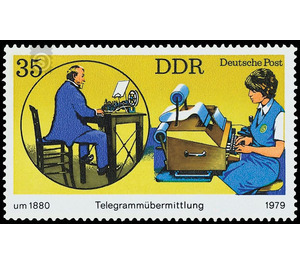Telephone exchanges and telegrams earlier and today - Germany / German Democratic Republic 1979 - 35 Pfennig
Theme: Communication & Media
| Country | Germany / German Democratic Republic |
| Issue Date | 1979 |
| Face Value | 35.00 |
| Color | yellow |
| Perforation | K 14 |
| Printing Type | Rotogravure 2 |
| Stamp Type | Postage stamp |
| Item Type | Stamp |
| Chronological Issue Number | 2143 |
| Chronological Chapter | GER-DDR |
| SID | 573905 |
| In 18 Wishlists | |
Telephone exchange and telegram transmission earlier and today With representations from the telephone exchange and telegram transmission past and today, the Ministry of Post and Telecommunications of the German Democratic Republic issued two multicolored special postage stamps. Special cancellation from 6 February to 5 April 1979 35-pfennig value: telegram transmission around 1880 and 1979 The telegram transmission was made around 1880 by means of a telegraph apparatus, which developed the American Hughes 1855. This apparatus offered the possibility of printing the transmitted message instead of the previous symbol font (Morseapparat) in the form of immediately readable characters on paper strips. For character transmission served a piano-like keyboard, arranged in two rows of 14 keys. The technical prerequisites of the telegraph apparatus and the then existing transmission conditions made possible only the transmission of about 200 characters / minute. Today, telegraph transmission is generally provided by the teletype machine, which combines the advantages of the typewriter and the telegraph and enables the direct exchange of written messages by telegraphic means. The teletypewriter transmits about 420 characters / minute and can be used as a chart recorder or a strip chart recorder. With the expansion of the subscriber telegraph network (telex network), the sheetfile has become increasingly important, especially for business and industry, because it can be used to ensure a faster and clearer exchange of messages. The ever-increasing need for communication places further and higher demands on the quantitative and qualitative transmission of messages via teleprinters, which must be taken into account above all by increasing the telegraph speed.


